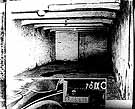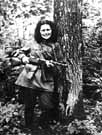
|
|
|

|

|

|

|
|
Click on an image to see a larger, more detailed picture.
|
|
|
|
|
| 1942: The "Final Solution" |

|
pg. 295 |

|
|
|
|
| |
|
|
|
|
|
|
| |
How to do those things, given the vast scope envisioned for the Final Solution and thus the inadequacy of mass shooting, was not crystal clear. But in his Wannsee Conference remarks, Heydrich had spoken about "practical experience" that was being collected "in relation to the future Final Solution of the Jewish problem." As 1942 developed, such experience was put to practical use in six major killing centers operational on Polish soil: Belzec, Sobibór, Treblinka, Majdanek, and Auschwitz-Birkenau as well as Chelmno. At each of those places, gas chambers--some using carbon monoxide, others using Zyklon B--destroyed Jewish lives. One Wannsee Conference participant, Dr. Josef Bühler, state secretary of the Generalgouvernement--the German administrative unit in Occupied Poland that contained many Jewish ghettos in the districts of Galicia, Kraków, Lublin, Radom, and Warsaw--had urged that "the Jewish question in this territory be solved as quickly as possible." In fact, he argued, the Final Solution could well start there because transportation problems were minimal and most of the Jews in that part of Poland were no longer fit for work anyway. Bühler's wish did not come true immediately, but on July 19 SS chief Heinrich Himmler ordered the "resettlement" (extermination) of "the entire Jewish population of the Generalgouvernement" by the end of the year. On July 22 Warsaw Ghetto Jewish Council leader Adam Czerniaków received German orders to provide a daily quota of 6000 Jews, including children, for deportation. Overwhelmed by the orders he had received, Czerniaków committed suicide in Warsaw on July 23. Nevertheless, the newly opened death camp at Treblinka destroyed its first transport of Warsaw Jews that very day. By mid-September more than 250,000 Warsaw deportees had been murdered at Treblinka. Jewish ghetto leaders confronted one "choiceless choice" after another. On September 3, 1942, Mordechai Chaim Rumkowski, the Jewish Council leader in Lódęz, Poland, was ordered "to send more than 20,000 Jews out of the ghetto." The quota, Rumkowski told a terrified crowd the next day, must consist of sick and elderly people and, even more devastating, children under the age of ten. Ever hopeful that salvation might come through work, Rumkowski cried, "Brothers and sisters, hand them over to me! Fathers and mothers, give me your children!...The part that can be saved is much larger than the part that must be given away." Other leaders of Jewish councils, notably Dr. Elchanan Elkes, who headed the Kovno Ghetto in Lithuania, actively supported forest-based partisan units and anti-Nazi underground activity in the ghettos. However, neither those efforts, nor a declaration entitled "German Policy of Extermination of the Jewish Race," which the Allied governments issued on December 17, 1942, could do anything to lift the death sentence that Nazi Germany had pronounced on Europe's Jews. The Allies' declaration identified Nazi Germany's "intention to exterminate the Jewish people in Europe," condemned "in the strongest possible terms this bestial policy of cold-blooded extermination," and affirmed that the perpetrators "shall not escape retribution." Important though it was as the first and strongest public condemnation of atrocities against the Jews that was issued by the Allies during World War II, the fact remained that 1942 was the most lethal year in Jewish history: 2.7 million Jews had lost their lives.
|

|

|

|

|
|

This gas chamber in the main camp at Auschwitz operated throughout 1942, and used Zyklon B to murder thousands of Jews.
Photo: Zbior Fotografil
|
|

Hesia Strom was a member of the Kovno (Lithuania) Ghetto Resistance.
Photo: Jewish State Museum of Lithuania / United States Holocaust Memorial Museum Photo Archive
|
|
|
|
|
| 1942: The "Final Solution" |

|
pg. 295 |

|
|
The Holocaust Chronicle
© 2009 Publications International, Ltd.
|
|
